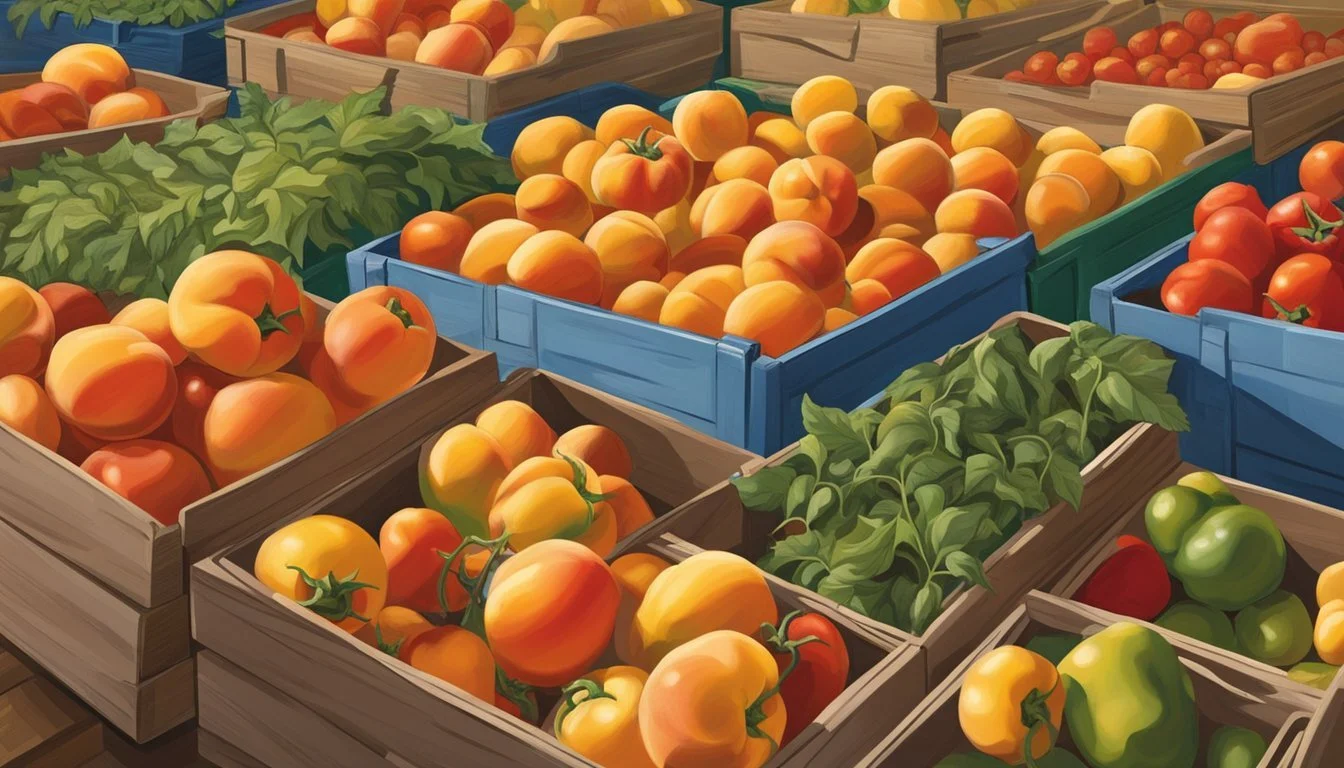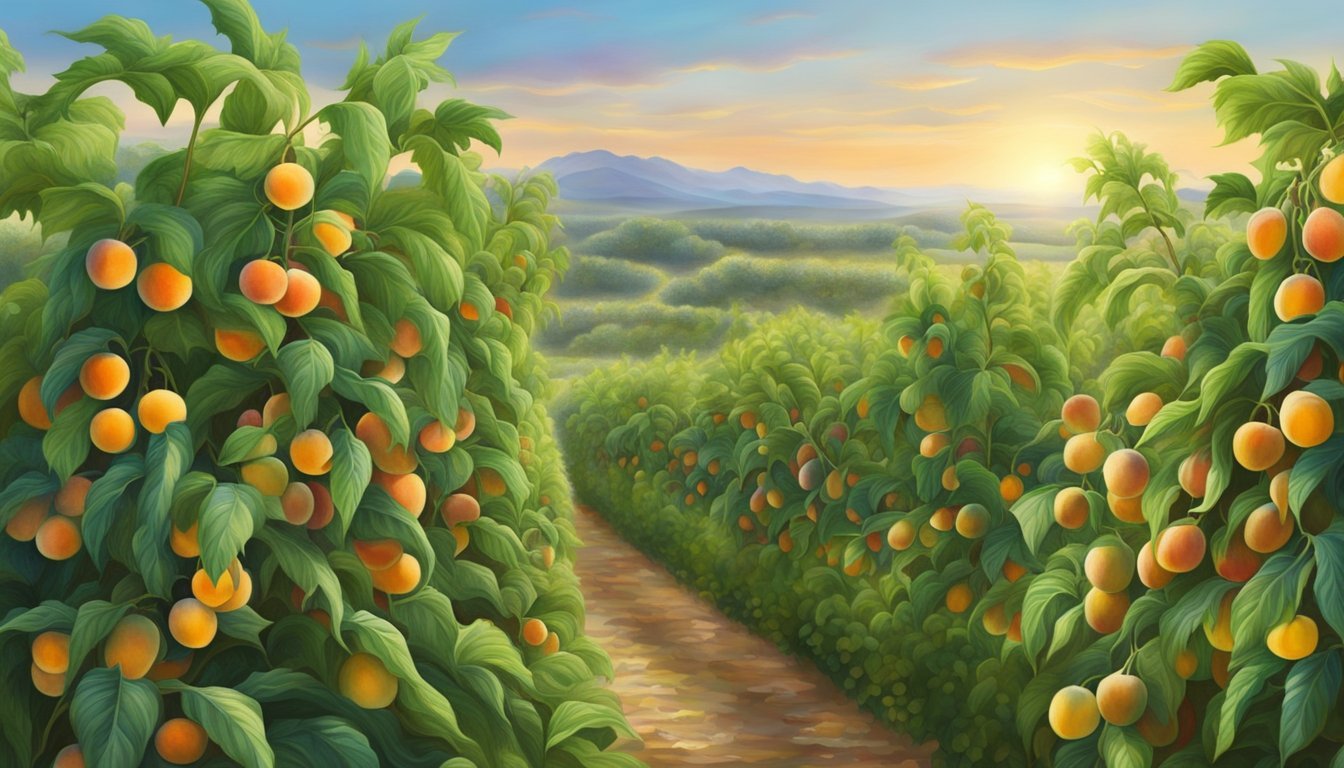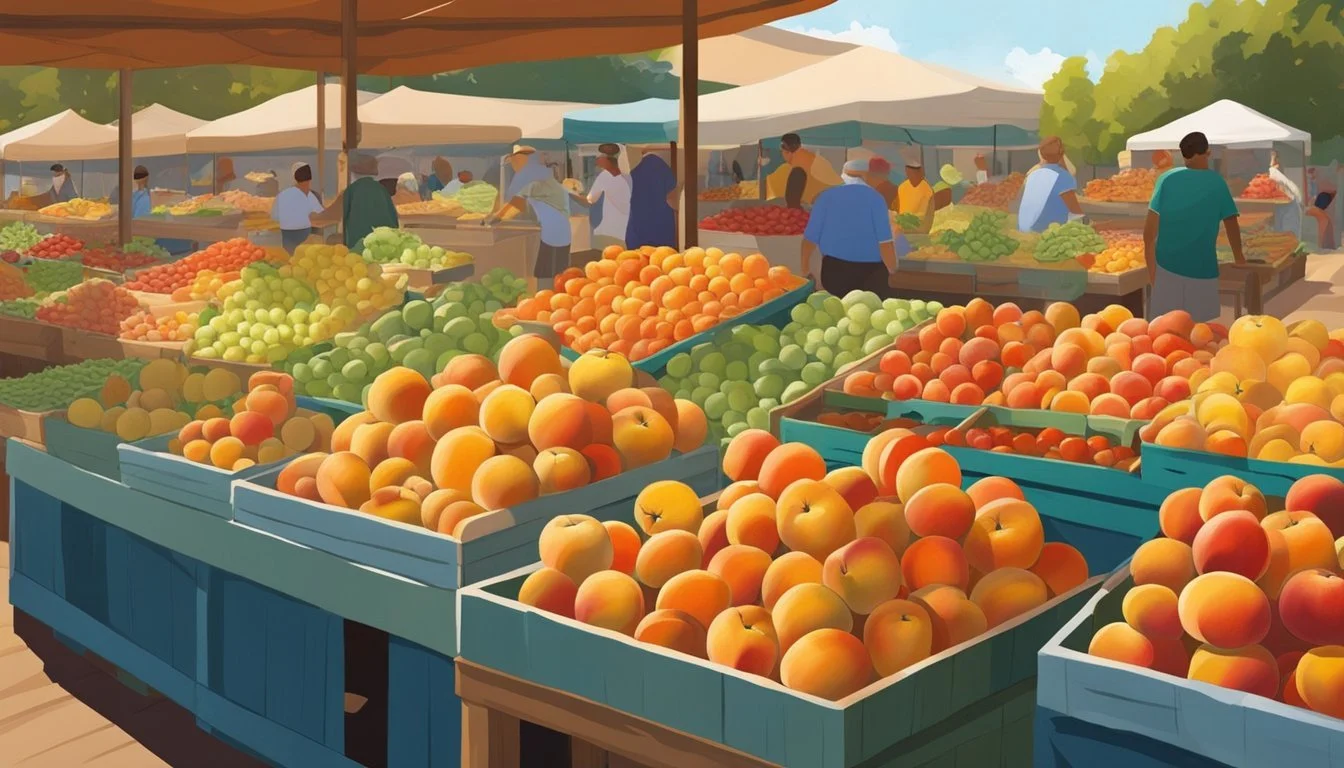Oklahoma Seasonal Fruit & Vegetables in September
Your Fresh Produce Guide
This Article is Part of our Oklahoma Seasonal Fruit & Veg Calendar
September in Oklahoma ushers in a shift in agricultural rhythm as the state transitions from the heat of summer to the cooler embrace of fall. It is a month characterized by a unique blend of produce, with the last of the summer fruits and vegetables mingling with the first harvests of autumn. Farmers and gardeners across the state are busy harvesting a bountiful variety of crops during this time, providing a plethora of fresh and nutritious options for consumers.
Seasonal produce available in Oklahoma during September includes a rich array of fruits and vegetables. The fruit harvest brings with it apple varieties such as Golden Delicious and Red Delicious, which are known for their adaptability to the state's climate conditions. These fruits are treasured for their versatility in the kitchen and their capability to thrive even when the weather grows colder. On the vegetable front, the cooler temperatures provide optimal growing conditions for a range of hearty vegetables.
Consumers can enjoy the robust flavors of Brussel sprouts, cabbage, and carrots, which are just a few of the nutrient-rich options at their peak this month. Other vegetables like kale, (What wine goes well with kale?) spinach, and various squash varieties come into season, contributing to the diverse palette of flavors that define Oklahoma's September. This convergence of summer and fall offerings makes for an exciting time for those interested in locally grown, seasonal eating.
Understanding Oklahoma's Growing Seasons
Oklahoma's growing seasons are distinguished by a gradual transition from spring to fall, with September acting as a pivotal month where summer's heat begins to give way to cooler autumnal temperatures. This period is crucial for determining the harvest times and planting schedules for various crops.
Spring to Fall Transition
During the transition from spring to fall, Oklahoma gardeners and farmers experience a significant shift in agricultural activities. Summer crops are reaching the end of their season, while fall plantings need to commence to ensure a successful harvest. This period requires keen attention to both soil warmth and the first signs of the cooling trend.
Summer crops: Tomatoes, peppers, okra
Fall crops: Pumpkins, squash, kale
September Weather Patterns
September brings a mix of warm days and cooler nights, with average temperatures ranging from highs of 85°F (29°C) to lows of 60°F (15°C). This fluctuation can affect crop yields, as plants prepare for the onset of colder weather. Adequate sunlight during the day and the avoidance of early frosts are pivotal for the maturation of late-summer produce.
Average high/low temperatures: 85°F/60°F
Key consideration: Avoiding early frost damage
Oklahoma's Hardiness Zones
Oklahoma is primarily comprised of USDA Hardiness Zones 6 through 8, which guide gardeners on plant survivability based on cold extremes. Knowledge of one's specific zone assists in selecting the right plants for the environment and anticipating their response to Oklahoma's variable heat and cold patterns.
Zone 6: Average minimum temperature of -10 to 0°F
Zone 7: Average minimum temperature of 0 to 10°F
Zone 8: Average minimum temperature of 10 to 20°F
Understanding these hardiness zones is crucial for successful year-round gardening, impacting when to sow, transplant, and harvest.
What's In Season in September
In September, Oklahoma's produce selection is diverse, offering a flavorful array of fresh fruits and vegetables. This is the optimal time for consumers to find ripe, local produce at the peak of its freshness.
Fruits
Apples:(how long do apples last?) Varieties like Gala and Honeycrisp are typically harvested beginning in late August through October.
Figs: These become ripe towards the end of summer and can be found fresh in early September.
Pears: Bartlett and other varieties start to reach peak ripeness this month.
Vegetables
Lettuce: Fresh fall harvest begins, with many varieties available.
Spinach: Cool early fall temperatures make for ideal conditions for spinach growth.
Kale: Robust and hearty, kale thrives in the cooler temperatures of September.
Pumpkins: While often associated with October, pumpkins start to become available in September.
Squash: Both summer and winter squashes are abundant, with varieties like zucchini winding down and butternut becoming more prevalent.
Benefits of Seasonal Eating
When Oklahomans choose seasonal produce, they tap into a peak harvest that promises fresh flavors, optimal nutrition, and minimal environmental stress.
Freshness and Flavor
Seasonal fruits and vegetables in Oklahoma are typically picked at their prime and reach the consumer quickly. This results in crisper textures and more robust flavors compared to produce that has traveled long distances or has been stored for extended periods.
Nutritional Value
The nutritional content of fruits and vegetables begins to decline the moment they are harvested. Oklahoma's seasonal produce is often richer in vitamins, minerals, and antioxidants due to the short time between harvest and consumption.
Environmental Impact
Choosing fruits and vegetables based on the Oklahoma harvest calendar helps reduce transportation distances. This leads to lower carbon emissions and a smaller environmental footprint. Additionally, it supports sustainable farming practices that are more in tune with the state's climate and soil conditions.
Harvesting Tips and Techniques
Harvesting in Oklahoma during the month of September requires an understanding of the correct techniques to ensure the quality and longevity of the produce. Whether one is dealing with the sweet fruits or the hearty vegetables from the garden, each group demands specific approaches for optimal harvest.
Fruit Harvesting
When harvesting fruits, it is essential to check for ripeness. Fruits should come off the plant with a gentle twist; if they resist, they may need more time to mature. For example, apples should be firm and fully colored. To pick an apple, roll the fruit upwards off the branch and give a slight twist—never pull directly downwards. Monitor for pests and diseases that may affect the fruit quality and address them promptly.
Peaches: Wait until the color deepens and the flesh feels soft to the touch.
Pears: They should still be firm when harvested; they ripen off the tree.
Vegetable Harvesting
Vegetable harvesting requires checking for size and maturity. Vegetables like tomatoes are best picked when they show full color but are still firm. Root crops like radishes and carrots must be pulled when they reach usable size, not leaving them too long in the ground to avoid becoming woody.
Leafy Greens: Harvest in the morning when temperatures are cooler to prevent wilting.
Beans: Pick them before the seeds inside begin to bulge, ensuring tenderness.
For both fruits and vegetables, consistent harvesting encourages the plant to produce more. Handle all produce with care to prevent bruising. Using the correct technique for each plant type in the garden shall lead to a fruitful harvest season.
Pest and Disease Management
Effective pest and disease management in Oklahoma during September is critical for maintaining the health and productivity of seasonal fruits and vegetables. Vigilant monitoring and strategic action can prevent the detrimental effects of common pests and diseases.
Common Pests
In Oklahoma's September gardens, insects such as aphids pose a significant threat to plant health. They sap nutrients and can spread diseases quickly. Gardeners should also be mindful of deer, rabbits, and squirrels which can cause physical damage to crops, either by chewing on the foliage or by harvesting the fruits and vegetables for themselves. Here are some pests typically encountered:
Aphids: These pests can be found in clusters, usually under leaves or on new growth.
Deer: They graze on a variety of vegetables and can strip a garden overnight.
Rabbits: These critters favor tender young shoots and can girdle young fruit trees.
Squirrels: Known for digging and can disturb young plants and eat fruits.
Disease Prevention Strategies
To reduce the incidence of disease, it is essential to implement preventative strategies:
Rotate crops regularly to prevent the buildup of pathogens in the soil.
Prune and thin plants to improve air circulation.
Water at the base to keep foliage dry and minimize the spread of fungal diseases.
Use disease-resistant plant varieties whenever possible.
Regular inspection of plants for symptoms of disease, such as discoloration, spots, or rot, facilitates early detection and more effective control.
Cultivating a Successful Home Garden
Creating a flourishing home garden in Oklahoma requires strategic planning, plant selection, and soil management. By focusing on these fundamental aspects, gardeners can expect a rewarding harvest in September.
Selecting the Right Plants
Choosing plants suited to Oklahoma's climate is crucial for garden success. September is an opportune time to harvest summer vegetables while beginning to transition to cool-season crops. Gardeners should consider the following plants:
Beans
Beets
Broccoli
Cabbage
Cauliflower
Swiss Chard
Kohlrabi
Leaf Lettuce
Radishes
Herbs:
Parsley
Cilantro
Dill
Avoid delicate plants that cannot withstand the cooler nights, and opt for hardy varieties that thrive in the transition between seasons.
Garden Planning and Layout
A well-planned garden maximizes space and sunlight exposure. One should account for the following:
Sunlight: Arrange plants so that taller crops don't shade shorter plants needing full sun.
Space: Utilize vertical gardening techniques for climbing plants like beans and peas to save space.
Accessibility: Place plants requiring frequent harvesting (like herbs) in easily accessible areas or gardening pots.
Rotation: Rotate crops from the previous year to prevent soil depletion and reduce disease risk.
Soil and Fertilization
Soil quality is paramount for plant health and yield. Gardeners must:
Test the soil to tailor fertilization needs.
Use compost to improve soil structure and nutrient content.
Apply herbicides judiciously, respecting the label's instructions to avoid harming the plants.
A balanced approach to fertilization ensures the plants receive essential nutrients without excess that could lead to runoff and potential environmental harm.
Preparation and Preservation of Produce
In Oklahoma, September's harvest yields a bounty of fruits and vegetables. Preserving this produce ensures a continuous supply of home-grown flavors throughout the year. Properly handled through methods like canning and freezing, or drying and pickling, these foods can retain much of their nutritional value and taste.
Canning and Freezing
In the canning process, Oklahoma's gardeners can seal in the freshness of September's vegetables—like spinach, lettuce, and radishes—using a high-temperature treatment. Recipes for canning usually involve:
Sterilization of jars and lids
Boiling of the fresh produce
Filling of jars and sealing them with the boiled lids
For freezing, it is essential that one blanches vegetables, which involves:
Briefly boiling them
Submerging in ice water to halt the cooking process
Drying and packing them in airtight containers
Canning should adhere to tested recipes and guidelines to prevent foodborne illnesses, while freezing requires minimal preparation and is often used for preserving Oklahoma’s fresh fruits like peaches or berries.
Drying and Pickling
Drying lends itself well to preserving the robust flavors of herbs and some sturdy vegetables. The process includes:
Washing and evenly slicing produce
Placing items in a dehydrator or a low-temperature oven
Storing dried produce in airtight containers in a cool, dark place
Pickling, another favorite, utilizes acidic solutions like vinegar or brine to create preservation-friendly environments, especially for cucumbers and okra from Oklahoma’s September harvest. Below are the basic steps:
Prepare a pickling solution (vinegar, water, and salt are common)
Clean and cut produce as needed
Place produce in jars, cover with pickling solution, and seal
The recipes and methods for drying and pickling should be meticulously followed to ensure long-term preservation, maintaining safety and flavor.
Seasonal Recipes and Cooking Tips
September in Oklahoma brings a bounty of fresh produce perfect for creative and nutritious meals. Home cooks and chefs alike can take advantage of the season’s harvest to create dishes that are both flavorful and healthful.
Appetizing Starters
The onset of fall calls for starters that are light yet satisfying. Using fresh kale and spinach, one can prepare a vibrant green salad topped with roasted pecans (how long do pecans last?) and pomegranate seeds (how long do pomegranate seeds last?) for added texture and flavor. Simple dressings made with onions and garlic complement the greens without overpowering them. Butternut squash soup is another great option, with its creamy texture and subtle sweetness enhanced by a touch of fresh fennel (how long does fennel last?).
Main Courses
For the main course, the plethora of seasonal vegetables at one's grocer offers a chance to highlight dishes that comfort and satisfy. Hearty stews or casseroles featuring pumpkins, potatoes, and onions can be slow-cooked to perfection. Vegetarian stuffed peppers with a filling of quinoa, collards, and diced tomatoes provide a healthy and substantial entrée. Grilled or roasted acorn squash, filled with a mixture of sautéed kale, garlic, and leeks, makes for a rustic and flavorsome dish.
Desserts
Desserts using fresh, seasonal produce can cap off any meal with a touch of sweetness. Baked apples stuffed with cinnamon and pecans offer a simple yet delightful treat. Pumpkin pie and butternut squash custards ((how long do custards last?)) are traditional favorites that proudly showcase the flavors of the season. Quick breads and muffins incorporating zucchini or carrots are not only delicious but also an easy way to add vegetables to one's diet.
Finding Local Produce
In Oklahoma, September brings a wealth of local produce to the forefront, ripe for the picking. Consumers can access this fresh food bounty through various outlets, ensuring that seasonal fruits and vegetables are readily available.
Farmers' Markets
Farmers' markets are a hub for fresh seasonal produce directly from local farmers. They typically offer a wide array of products, from ripe fruits to hearty vegetables. In September, one can expect to find Oklahoma farmers showcasing items like apples, okra, peppers, and tomatoes. Shopping at a farmers' market not only provides consumers with fresh ingredients but also supports the local agricultural community.
Key Seasonal Items in September:
Apples
Okra
Peppers
Tomatoes
Community Supported Agriculture
Community Supported Agriculture (CSA) programs allow individuals to purchase a share of a farmer's harvest in advance. Members of a CSA receive regular distributions of fresh, local produce throughout the farming season. This system is a great way for consumers to establish a direct relationship with growers and obtain a variety of just-harvested produce including squash, leafy greens, and root vegetables.
Benefits of CSAs:
Guaranteed share of the harvest
Regular supply of fresh produce
Support of local farmers
Seasonal variety
Grocery Stores and Co-ops
Grocery stores and food cooperatives often source from local growers to provide fresh, seasonal options. Shoppers should look for signage indicating local produce or ask staff for guidance. Co-ops, in particular, are community-owned and place a strong emphasis on locally-sourced and organic options. They can be an excellent source for finding seasonal fruits and vegetables like squashes and greens.
What to Look for:
Signage for local produce
Seasonal fruits and vegetables
Organic and locally-sourced options
Contributing to Oklahoma's Agricultural Economy
In September, the agricultural economy of Oklahoma benefits significantly from the sale of seasonal fruits and vegetables. This period supports local farmers and entices tourists, positively impacting the state's economic health.
Supporting Local Farmers
In September, Oklahoma's farmers bring to market a variety of fresh produce, contributing to the state's agricultural economy. The Oklahoma Department of Agriculture, Food, and Forestry (ODAFF) recognizes that fruits like peaches and apples, and vegetables such as sweet potatoes and pumpkins, are not only integral to the farmers' livelihoods but also add millions to the economy. These sales support farm families and reinvest in the local communities.
Key Produce in September:
Peaches
Apples
Sweet potatoes
Pumpkins
Agriculture and Tourism
Agriculture in September intertwines with tourism, creating a multifaceted economic benefit for Oklahoma. Visitors flock to local farms for activities like apple picking and pumpkin patch tours, providing additional revenue streams. These agritourism experiences, while highlighting Oklahoma's agricultural heritage, simultaneously bolster the state's economy.
Agritourism Activities:
U-pick orchards
Pumpkin patch tours
Fall festivals
Oklahoma’s agricultural sector thrives during September, with both farmers and the state profiting from the robust sales and tourism opportunities.









